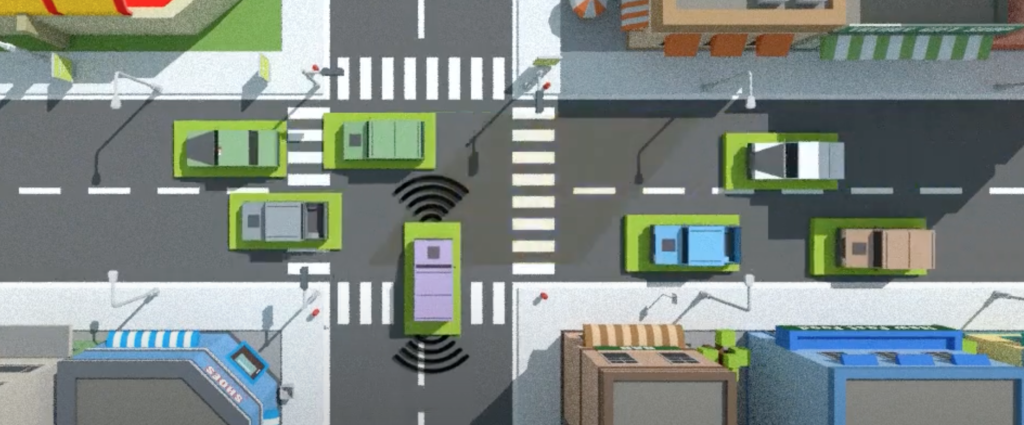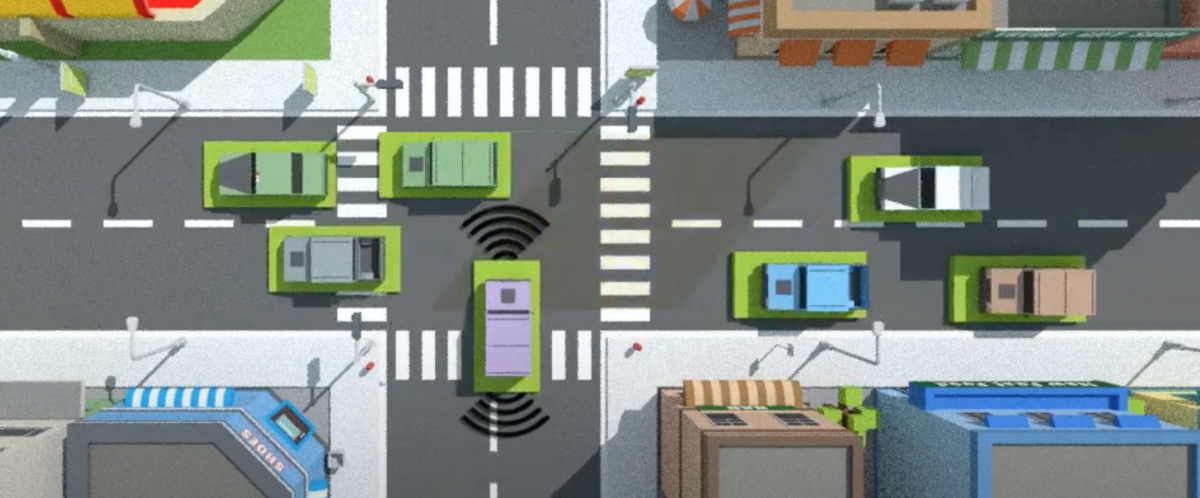Imagine a city where all cars drive autonomously. In such a city, traffic could flow much more efficiently because a central intelligence could control the cars and interleave them at intersections. Also, you would never have to look for a parking space: Your car could drop you off at your destination and then find a parking space on its own. We are still a long way from fleets of self-driving cars, but the Carfax concept aims to change that by equipping all cars with a self-driving platform.
Introduction
The concept of CarFax was created by a friend of mine, Encho Hristov. You can find details about the concept and animations on his homepage www.carfax.today. The word CarFax is a combination of “car” and “fax”. The idea is that you can “send” your car to a destination, similar to a fax you send over the line.
The principle of CarFax is that a city or a smaller part of a city is equipped with platforms that can drive autonomously and that can carry conventional cars. The platforms pick up the cars with the passengers inside. Then the platforms drive the car to its destination, the passengers get out, and the platform continues on to a parking lot where it drops off the car. The same happens on the return trip, where a platform first picks up your car from the parking lot, then picks you up and takes you home.
In this sense, we can think of this idea as a variant of Automated Valet Parking (AVP), scaled up to serve an entire city.
In this way, CarFax would allow users not to worry about how and where to park their cars, thus providing more convenience.
In addition, parking spaces no longer need to be close to work or shops, but can be located further away. This in turn would lead to greener cities, as there would be more space for parks or sidewalks.

There is another benefit that CarFax promises: If all cars in a city are transported by CarFax, then we no longer need to consider the human factor in driving. Intersections could work more efficiently because the cars could coordinate which one is driving at what time, avoiding collisions while achieving higher capacity and fewer stops.

So Encho’s vision of the CarFax system promises us greener, more livable cities, a more relaxed commute, and an end to the search for parking spaces. So far, the system is in a conceptual stage, but Encho is looking for potential investors to help him build a proof of concept. If you are interested, you can contact him via LinkedIn.
Challenges
Every new idea has challenges that need to be overcome before it can be widely adopted. Here are the challenges to the CarFax system that I can see at the moment.
Platform Design
Designing the platform presents several challenging issues.
The first is the autonomous driving itself. The platforms must be able to drive autonomously. In principle, this obstacle can be overcome because the first autonomous driving taxis are now in use, for example in San Francisco. This means that self-driving platforms could be possible. The challenge would be where to put all the sensors that self-driving cars have. Cars have cameras, radars, and lidars all over their bodies, especially on the roof. Where would these sensors go on the platform, which would have to be flat and fit under the car? And would it be able to provide the all-round vision needed to drive itself?
The next question is how to power the platforms. The platforms will need enough energy storage capacity to carry a car, usually weighing several tons, around a city. This means that the battery would be quite bulky, which would affect the shape of the platform. I think it could not be the relatively small robots that are used for AVP today. Instead, the platform would become quite large, which means it would take up more space. The large battery would make it more expensive, because even with EVs, the battery pack is usually the most expensive part.
If the battery gets bigger, the whole combination of car and platform gets bigger and heavier, which means it needs stronger brakes and the stopping distance can get longer.
Another factor that makes the platforms bigger than those used for AVP is that they need to go much faster than the speed you need to park a car. This in turn means you need powerful motors and larger wheels.
The question of the sensors needed for autonomous driving and the size of the battery pack and wheels brings up the question of the design of the platforms. How big do they really need to be? And if they are big, how do they pick up cars? Can they just drive under the car and pick it up, like the AVP robots? Or do they need a special mechanism to lift a car on top? The right design for this will be crucial and, in my opinion, will be the most technically difficult part of the project.
And what about vehicles that are larger than cars? Vans, trucks, ambulances, fire trucks, cranes, etc.? What kind of platform can lift and carry them? Is it even possible?
Interfaces
To achieve all the benefits of the CarFax system, the platforms should be the only vehicles on the road. Human driven cars would no longer be allowed in the city. This raises the question of the interface to the rest of the world: How do you get your car in and out of the system when you cross the city limits?
I imagine it could look like a border crossing. We could have multiple lanes where cars slowly move forward. Then the cars at the front are picked up by the next available platform, which then starts its journey inside the city.
The exit of the system could be similar to the exit of a car wash: The platform takes you to the road out of town, slows down, and then gives you a signal to drive yourself.
Using these analogies, I think it should be possible to design these interfaces between the manual driving world and the CarFax world, but it will be difficult to get it right and avoid making people anxious at these critical moments of transition. Anxious people cause accidents, and that could lead to traffic jams that the system is designed to avoid.
Economic Viability
How many platforms do we need to keep the traffic flowing in a city? On the CarFax homepage, Encho writes that 7,000 platforms would be enough for the entire city of Munich. Unfortunately, there are no details on how he came up with these numbers. My back-of-the-envelope guess is that we would need many more.
If we think about a scenario where all the traffic in a city is handled by the CarFax system, then the system needs to be designed to handle peak demand during rush hour. I am still convinced, as I was many years ago, that people do not want to change their travel patterns just to fit the technology, but that the technology needs to fit their patterns. So everyone is still going to go to work at the same time, which means we need as many platforms as there are cars on the road at any given time. Worse, not only do you need the platforms for the people who are currently on the road, but you also need more platforms to pick up commuters who want to start their journey before the platforms carrying the current commuters have had time to return to their starting point. A city like Munich has more than a million daily commutes (source). Surely not all of them are done by car, but a very high percentage is. If we assume only 10%, we would have to carry 100,000 cars in Munich alone. And we have to assume that most of these movements need their own platform. So the demand for platforms would be huge.
Buying such a large number of platforms would of course be very expensive. How much could a unit cost?
I think the cost could be in the range of a small electric car. For the platform, we need the components for the drivetrain, as well as the sensors for autonomous driving and the control units, antennas, etc. On the other hand, we do not need seats, a human-machine interface, or air conditioning. My first guess would be around €10,000, but with mass production – we do not need customization – the price could come down further. So let’s say €5,000, just to have a number to play with.
100,000 platforms at €5,000 would mean an initial investment of €500,000,000 – five hundred million. Of course, you have to add in the cost of maintenance facilities, charging stations, personnel, etc.
This sounds like a lot, but on the other hand, building new infrastructure in cities, especially tunnels, often comes with a price tag of several billion Euros. So it is not inconceivable that a city would make such an investment.
Of course, these estimates will be wrong in many places. Nevertheless, I would venture to say that the figures are in a region where a major city could consider such an investment if the benefits are compelling.
Alternatives
However, before a city commits such a large amount of money, the city council will ask if there are cheaper alternatives.
One such alternative already exists: Self-driving cars. As I mentioned earlier, self-driving cars are a reality. Right now, they are mainly used for robo-taxis. Eventually, the technology will get better and cheaper, so more and more drivers will be able to enjoy it. Once enough cars are equipped with autonomous driving technology, cities could decree that manual driving is prohibited in their cities or in certain regions. They could remove parking spaces from the city center, forcing cars to drop off their passengers and find their way to special parking garages outside the center.
In this way, the city would enjoy the same benefits as the CarFax system, but at little or no additional cost to the city. Instead, the cost would be borne by the car owners, who would have to purchase cars with the necessary equipment.
Cities have the power to enforce such a policy – for example, many German cities do not allow you to enter the city center unless your car meets certain emission standards. This has encouraged many car owners to upgrade to newer, cleaner cars. This in turn achieved the goal of cleaner air in city cores.
A similar approach could eventually force the purchase of self-driving cars.
Outlook
The CarFax system is certainly an intriguing idea. It could bring the benefits of autonomous driving to both drivers and cities with existing technology. There are still many technical challenges, the design of the platforms being the biggest in my opinion.
Whether cities really invest in this technology will depend not only on the technical feasibility and the price of the platforms, but also on how quickly autonomous driving will spread to ordinary consumer cars, and thus whether car owners will make the investments instead of the city.
How will autonomous driving shape our cities in the future? The race is on!

One reply on “CarFax – Greener Cities through Autonomous Driving Platforms?”
[…] sense their environment? All sensors will have to be placed under the freight (similar to the Carfax concept), which is much lower than an engineer’s viewpoint. This will limit the maximum field of view […]